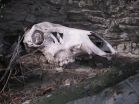(Press-News.org) COLUMBUS, Ohio – Engineers at Ohio State University have invented a new kind of nano-particle that shines in different colors to tag molecules in biomedical tests.
These tiny plastic nano-particles are stuffed with even tinier bits of electronics called quantum dots. Like little traffic lights, the particles glow brightly in red, yellow, or green, so researchers can easily track molecules under a microscope.
This is the first time anyone has created fluorescent nano-particles that can change colors continuously.
Jessica Winter, assistant professor of chemical and biomolecular engineering and biomedical engineering, and research scientist Gang Ruan describe their patent-pending technology in the online edition of the journal Nano Letters.
Researchers routinely tag molecules with fluorescent materials in order to see them under the microscope. Unlike the more common fluorescent molecules, quantum dots shine very brightly, and could illuminate chemical reactions especially well, allowing researchers to see the inner workings of living cells.
A bottleneck to combating major diseases like cancer is the lack of molecular or cellular-level understanding of biological processes, the engineers explained.
"These new nanoparticles could be a great addition to the arsenal of biomedical engineers who are trying to find the roots of diseases," Ruan said.
"We can tailor these particles to tag particular molecules, and use the colors to track processes that we wouldn't otherwise be able to," he continued. "Also, this work could be groundbreaking for the field of nanotechnology as a whole, because it solves two seemingly irreconcilable problems with using quantum dots."
Quantum dots are pieces of semiconductor that measure only a few nanometers, or billionths of a meter, across. They are not visible to the naked eye, but when light shines on them, they absorb energy and begin to glow. That's what makes them good tags for molecules.
Due to quantum mechanical effects, quantum dots "twinkle" – they blink on and off at random moments. When many dots come together, however, their random blinking is less noticeable. So, large clusters of quantum dots appear to glow with a steady light.
Blinking has been a problem for researchers, because it breaks up the trajectory of a moving particle or tagged molecule that they are trying to follow. Yet, blinking is also beneficial, because when dots come together and the blinking disappears, researchers know for certain that tagged molecules have aggregated.
"Blinking is good and bad," Ruan explained. "But one day we realized that we could use the 'good' and avoid the 'bad' at the same time, by grouping a few quantum dots of different colors together inside a micelle."
A micelle is a nano-sized spherical container, and while micelles are useful for laboratory experiments, they are easily found in household detergents – soap forms micelles that capture oils in water. Ruan created micelles using polymers, with different combinations of red and green quantum dots inside them.
In tests, he confirmed that the micelles appeared to glow steadily. Those stuffed with only red quantum dots glowed red, and those stuffed with green glowed green. But those he stuffed with red and green dots alternated from red to green to yellow.
The color change happens when one or another dot blinks inside the micelle. When a red dot blinks off and the green blinks on, the micelle glows green. When the green blinks off and the red blinks on, the micelle glows red. If both are lit up, the micelle glows yellow.
The yellow color is due to our eyes' perception of light. The process is the same as when a red pixel and green pixel appear close together on a television or computer screen: our eyes see yellow.
Nobody can control when color changes happen inside individual micelles. But because the particles glow continuously, researchers can use them to track tagged molecules continuously. They can also monitor color changes to detect when molecules come together.
Winter and Ruan said that the particles could also be used in fluid mechanics research – specifically, micro-fluidics. Researchers who are developing tiny medical devices with fluid separation channels could use quantum dots to follow the fluid's path.
The same Ohio State research team is also developing magnetic particles to enhance medical imaging of cancer, and it may be possible to combine magnetism with the quantum dot technology for different kinds of imaging. But before the particles would be safe to use in the body, they would have to be made of biocompatible materials. Carbon-based nanomaterials are one possible option.
In the meantime, Winter and Ruan are going to continue developing the color-changing quantum dot particles for studies of cells and molecules under the microscope. They are also going to explore what happens when quantum dots of another color – for instance, blue – are added to the mix.
The university will look to license the technology for industry, and Winter and Ruan have created a Web site for the technologies they are developing: http://nanoforneuro.com.
INFORMATION:
This research was supported by the National Science Foundation, an endowment from the William G. Lowrie family to the Department of Chemical and Biomolecular Engineering, and the Center for Emergent Materials at Ohio State.
Contacts: Gang Ruan: Ruan.12@osu.edu
Jessica Winter, Winter.63@osu.edu
[Both Ruan and Winter are best reached by email.]
Written by Pam Frost Gorder, (614) 292-9475; Gorder.1@osu.edu
Twinkle, twinkle, quantum dot -- new particles can change colors and tag molecules
2011-03-29
ELSE PRESS RELEASES FROM THIS DATE:
Bixby Land Company Acquires $58 Million in Industrial Properties
2011-03-29
Bixby Land Company, a leading commercial real estate operator and investment manager based in Orange County, Calif., has purchased four Class A industrial properties totaling approximately 850,000 square feet. The acquisitions increase Bixby Land Company's wholly-owned portfolio to more than 5 million square feet and point to Bixby's increasing investment activity as California property markets show signs of improvement.
"Our investment in these high-quality properties is a reflection of our confidence in the recovery of commercial real estate, in particular the industrial ...
The Birth of a Novel: Josie Brown's THE BABY PLANNER is Nurtured by the Profession it Touts
2011-03-29
Conception is a blessed event, be it a child's, or a new book. That is novelist Josie Brown's contention. She should know. The idea for her fourth novel, The Baby Planner [Simon & Schuster/Gallery Books]--about a childless woman who channels her nurturing instincts toward her pregnant clients--was born in the reception area of her mammogram center.
"I picked up the only reading material available: a local parenting magazine," explains Brown, who lives in the San Francisco Bay Area. "My own children are older, so it wasn't necessarily something I felt might interest ...
Deep-sea volcanoes don't just produce lava flows, they also explode!
2011-03-29
Between 75 and 80 per cent of all volcanic activity on Earth takes place at deep-sea, mid-ocean ridges. Most of these volcanoes produce effusive lava flows rather than explosive eruptions, both because the levels of magmatic gas (which fuel the explosions and are made up of a variety of components, including, most importantly CO2) tend to be low, and because the volcanoes are under a lot of pressure from the surrounding water.
Over about the last 10 years however, geologists have nevertheless speculated, based on the presence of volcanic ash in certain sites, that explosive ...
OAI: News of Fee Increase Highlights Peculiarities of Mich. Auto Insurance Market
2011-03-29
Last week, the Michigan Catastrophic Claims Associations (MCCA) announced it would be instituting a slight fee increase that will be passed on to policyholders in the state.
Car insurance providers currently are required to pay the MCCA $143.09 per insured vehicle, which gets incorporated into the premiums of even the cheapest auto insurance companies in the state. That amount will be raised 1.3 percent starting in July. The fee revenue goes into an MCCA-administered fund that exists as a result of the unorthodox structure of Michigan's no-fault system.
Unlike the ...
Bones conjure Yellowstone's ecological ghosts
2011-03-29
By taking a closer look at animal bones scattered across the wilderness landscape, a researcher at the University of Chicago has found a powerful tool for showing how species' populations have changed over decades or even a century.
"The skeletons of long-dead animals lying on landscapes provide critical insight into our understanding of ecosystem history, especially how populations have changed," said the study's author, University of Chicago alumnus Joshua H. Miller, S.M.'05, PhD'09, a postdoctoral research fellow in biological sciences at Wright State University in ...
AmeriSus Partners with HomeSphere
2011-03-29
Lakewood-based HomeSphere, Inc. announced today that they have entered into a partnership with the American Sustainability Initiative (AmeriSus) to effectively manage manufacturer rebates with their BRI and AllTrack applications.
Inspired by the Sears kit houses of the 1930s, AmeriSus manages all design, engineering, product and technology selections, procurement, logistics and scheduling for home builders, in order to deliver all materials necessary to construct an affordable, super-efficient homes for the end consumer. AmeriSus catalog homes are designed to fit into ...
Human virus linked to deaths of endangered mountain gorillas
2011-03-29
For the first time, a virus that causes respiratory disease in humans
has been linked to the deaths of wild mountain gorillas, reports a
team of researchers in the United States and Africa.
The finding confirms that serious diseases can pass from people to
these endangered animals.
The researchers are from the non-profit Mountain Gorilla Veterinary
Project; the Wildlife Health Center at the University of California,
Davis; the Center for Infection and Immunity at Columbia University;
and the Rwanda Development Board.
Their study, which reports the 2009 deaths ...
International Diabetes Federation supports surgery to treat diabetes
2011-03-29
NEW YORK (March 28, 2011) -- Bariatric surgery should be considered earlier in the treatment of eligible patients to help stem the serious complications that can result from diabetes, according to an International Diabetes Federation (IDF) position statement presented by leading experts at the 2nd World Congress on Interventional Therapies for Type 2 Diabetes in New York.
The statement was written by 20 leading experts in diabetes and bariatric surgery who have made a series of recommendations on the use of weight-loss surgery as a cost-effective treatment option for ...
Research proves no 2 of us are alike, even identical twins
2011-03-29
Just like snowflakes, no two people are alike, even if they're identical twins according to new genetic research from The University of Western Ontario. Molecular geneticist Shiva Singh has been working with psychiatrist Dr. Richard O'Reilly to determine the genetic sequencing of schizophrenia using identical or monozygotic twins. The study is published in this month's PLoS ONE.
Singh looked at about one million markers of identical twins (and their two parents) where only one twin had schizophrenia. "The most informative feature of schizophrenia is that it sometimes ...
How do plants fight disease?
2011-03-29
RIVERSIDE, Calif. – How exactly bacterial pathogens cause diseases in plants remains a mystery and continues to frustrate scientists working to solve this problem. Now Wenbo Ma, a young plant pathologist at the University of California, Riverside, has performed research on the soybean plant in the lab that makes major inroads into our understanding of plant-pathogen interactions, a rapidly developing area among the plant sciences.
Her breakthrough research can help scientists come up with effective strategies to treat crops that have succumbed to disease or, when used ...





